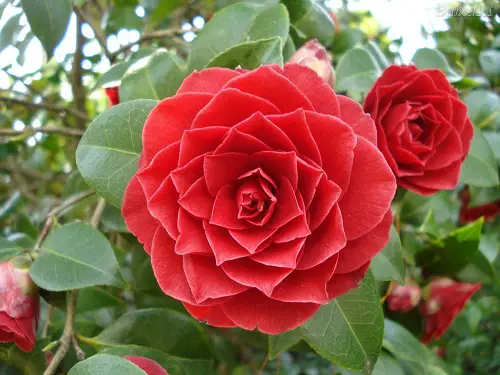Here are the 22 Most Endangered Flowers on the planet that need urgent protection! Let’s look at each one and the threats they face.
These incredible blooms, including the world’s largest flower, are teetering on the verge of extinction largely due to human activity. Since we’ve excelled at putting them in this perilous plight, perhaps it’s now time to show off our planting skills in saving the most endangered flowers on the planet!
What are Endangered Flowers?
Before we don our superhero capes and take off to save the plant world, let’s take a look at what the word “endangered” implies and its different degrees.
Endangered species are those that may be extinct soon, globally or locally. As per their dwindling numbers and the imminent threat of disappearing from their natural habitats, these rare plants are categorized as critically endangered, endangered, vulnerable, threatened, rare, or extinct in the wild.
Most Endangered Flowers
1. Ghost Orchid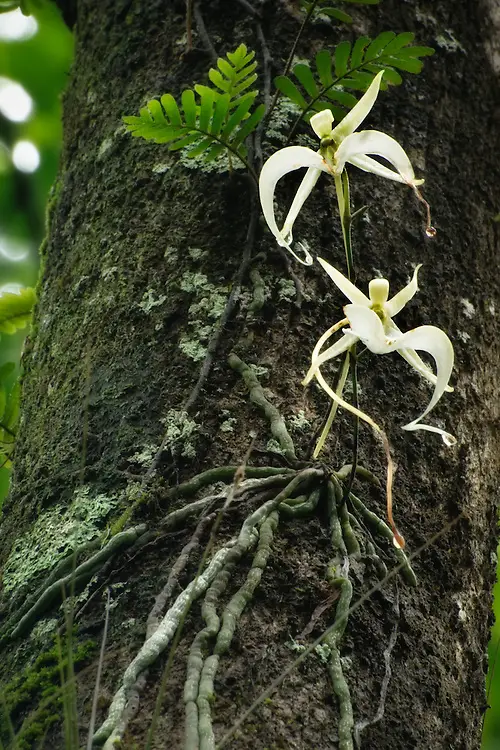
Scientific Name: Dendrophylax lindenii
Status: Critically Endangered
Ghost Orchids get their name from their pale white flowers, which appear suspended mid-air due to their translucent aerial roots. These amazing plants lack chlorophyll and depend on fungi for most of their lives. They only surface rarely to flower!
Native to Florida and regions of western Cuba, as of 2023, its population had dropped by more than 90 percent globally, with only 1500 plants remaining in Florida.
2. Chocolate Cosmos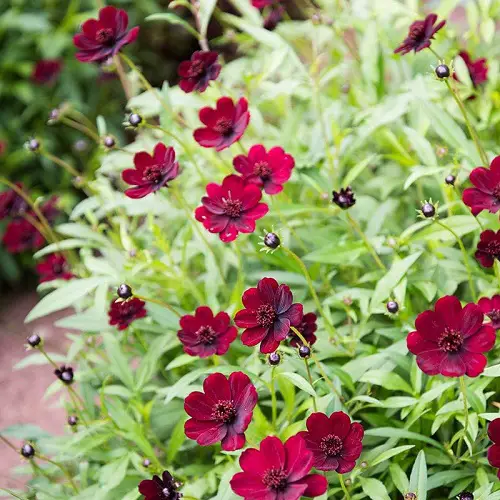
Scientific Name: Cosmos atrosanguineus
Status: Extinct in the wild
Chocolate Cosmos flowers have beautiful brown-red velvety petals that give off a chocolate-like scent. They are native to Mexico but were considered extinct in the wild there till 1986 when they were spotted in the pine and oak forests of some Mexican states.
The good news is that these blooms are found in domestic environments due to regular cultivation and consistent propagation. Efforts are being made to reintroduce them into their natural habitats gradually.
3. Gibraltar Campion

Scientific Name: Silene tomentosa
Status: Critically Endangered
Endemic to Gibraltar’s steep rocky cliffs, the Gibraltar Campion flowers have a rosette of leaves at their base and stunning mauve petals. Protected by the law of Gibraltar, these flowers were considered extinct for quite some time before they were rediscovered in the Upper Rock Nature Preserve in 1994.
Ever since efforts have been taken to grow these plants and reintroduce them to favorable conditions.
4. Kadupul Flower

Scientific Name: Epiphyllum oxypetalum
Status: Rare
Native to the tropical shores of Sri Lanka, this night-blooming cactus is quite different from its desert-dwelling cousins, both in appearance and growth habits. Its large, white blooms open after midnight and emit a fragrant aroma but wilt before morning.
While not endangered, the Kadupul flower is extremely rare and difficult to grow outside its natural habitat, making it one of the most expensive flowers in the world!
5. Middlemist Red
Scientific Name: Camellia
Status: Critically Endangered
Another one on our list of most endangered flowers, this prized red bloom, no longer exists in its native home of China!
Touted as the rarest flower on earth, there are only two specimens left: one in New Zealand and another in the UK’s Royal Botanical Gardens.
6. Lady’s Slipper
Scientific Name: Cypripedium calceolus
Status: Critically Endangered
This rare orchid produces pouch-shaped yellow and reddish flowers that grow on slender stalks and have a dreamy vanilla scent. Native to Europe and parts of Asia, these petite blooms are critically endangered.
Their decline is due to habitat destruction, the replacement of natural forests with domestic plantations, climate change, and illegal collection for the horticultural trade.
7. Corpse Flower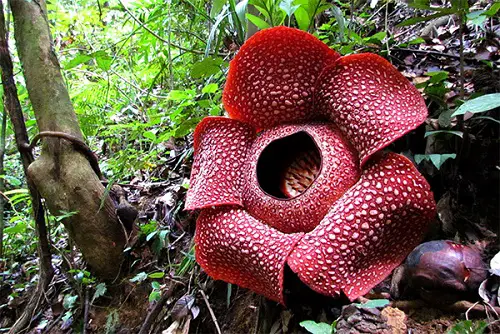
Scientific Name: Rafflesia arnoldii
Status: Critically Endangered
Known as the world’s largest and smelliest, the corpse flower is well on its way to extinction due to the loss of forest habitats. Found only in the rainforests of Sumatra and Borneo, these parasitic blooms smell like rotting flesh to attract carrion flies for pollination.
According to an investigation by the Guardian, all its species are close to extinction, and no conservation efforts are being made for more than two-thirds of this rare species.
8. Kaka Beak
Scientific Name: Clianthus maximus
Status: Critically Endangered
Endemic to New Zealand, these woody shrubs produce clusters of fiery flowers resembling a kaka or parrot’s beak. Revered by the Maori people of the island, its population has dropped to 153 mature plants in the wild, driving it close to extinction.
Grazing animals, erosion, wildfires, invasive species, and disease are some of the common threats. You can help grow them domestically via seed germination and cuttings.
9. Koki’o
Scientific Name: Kokia cookei
Status: Extinct in the wild
Koki’o flowers are bright red-orange and come from Hawaii. Considered one of the world’s most endangered flowers, these plants are now extinct in the wild. A study shows the species exists as 23 grafted plants on five different islands.
Common threats that led to its decline include the addition of non-native invasive plants in its region, grazing, habitat loss due to agriculture, and lack of seeds.
10. Jade Vine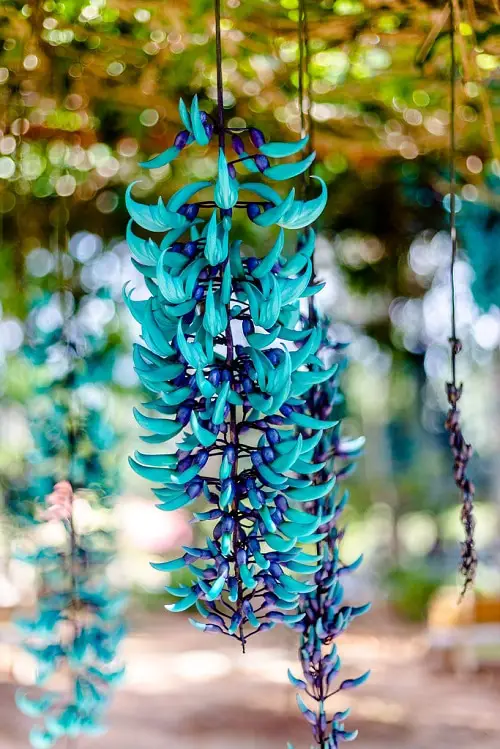
Scientific Name: Strongylodon macrobotrys
Status: Vulnerable
Producing exquisite clusters of hanging turquoise blue blooms, jade vines are fast disappearing from the wild due to habitat destruction and dwindling pollinators. Native to the strained rainforests of the Philippines, these cascading inflorescences use bats to pollinate.
They were cultivated in the botanical garden at Kew for the first time using this method.
11. Siroi Lily 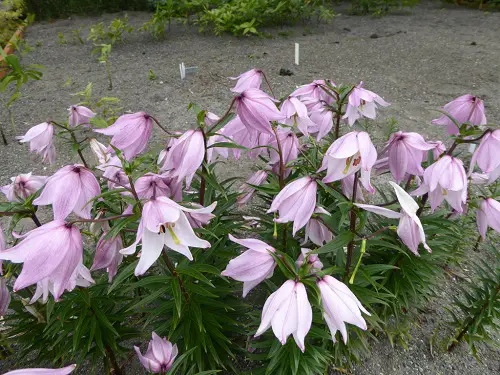
Scientific Name: Lilium mackliniae
Status: Endangered
These rare Asiatic lilies are found only in the Shirui Hills of Manipur in India. In the wild, they produce pale pink blooms with a bluish tinge during monsoons. In the late 1990s, these heritage flowers were declared the State Flower of Manipur, but they are endangered because of uncontrolled trampling, plucking, and pollution.
However, these endangered flowers are now grown in labs for further propagation.
12. Tennessee Coneflower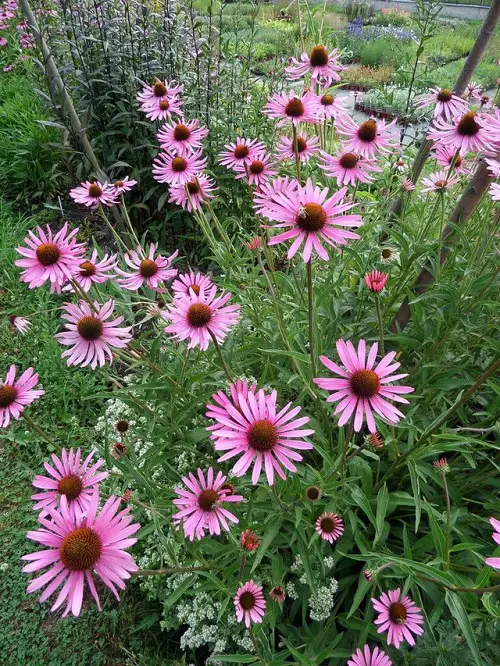
Scientific Name: Echinacea tennesseensis
Status: Vulnerable
An occasional happy story in this list of most endangered flowers, Tennessee Coneflowers were once listed as federally threatened but have been removed since, as their population gradually bounced back.
These sunflower relatives grow in the limestone barrens and cedar glades of Tennessee, featuring beautiful pink flowers with burgundy centers.
13. Franklin Tree Flower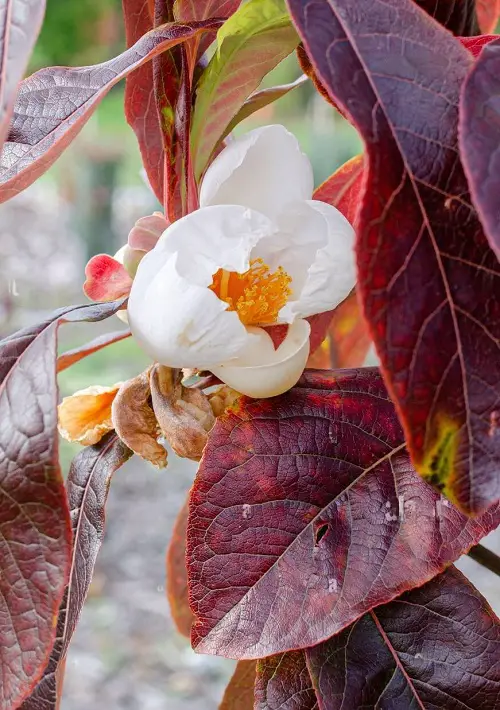
Scientific Name: Franklinia alatamaha
Status: Extinct in the wild
This small deciduous tree occurs only along the Altamaha River in the US state of Georgia. It has been eradicated from its native habitat since 1803 but is cultivated as an ornamental.
Prized for its large, fragrant, white stalkless flowers, all the current species have been cultivated from the seeds first collected by the Philadelphia botanist John Bartram back in 1765.
14. Autumn Crocus
Scientific Name: Colchicum autumnale
Status: Vulnerable in Ireland, other parts of the UK
Autumn Crocus populations are also declining. They are endangered in Great Britain and critically so in Ireland. Typically growing in damp meadows, wetlands, and grassy fields, these toxic species suffer from habitat loss, drainage projects, and changes in land use due to agriculture. However, these flowers are being restored via conservation efforts.
15. Vietnamese Paphiopedilum

Scientific Name: Paphiopedilum vietnamense
Status: Critically Endangered
In 1997, this orchid species was discovered in the Thái Nguyên region in Vietnam. Horticultural trade led to this rare orchid being exploited and over-collected, leading to its critically endangered position.
Producing pouty large blooms in pale pink and purple, most paphiopedilum species are in danger of extinction, with many no longer found in the wild.
16. Western Underground Orchid
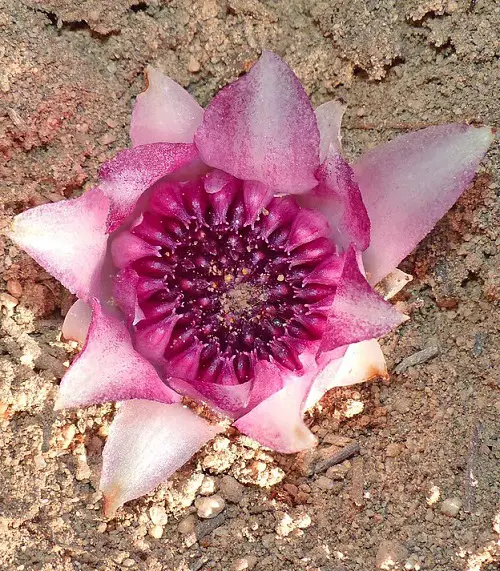
Scientific Name: Rhizanthella gardneri
Status: Critically Endangered
These endangered Australian orchids are actually herbs that flower right at the soil’s surface or just below it. Up to 100 red and pink inward-facing flowers emerge with large creamy bracts–truly a sight to behold.
Drought and habitat loss due to agriculture have negatively affected its survival, driving it rapidly to extinction.
17. Canary Island Bellflower
Scientific Name: Canarina canariensis
Status: Threatened
This flower is native to the Canary Islands and is the community’s national flower. It has a distinctive orange, bell-shaped bloom. Habitat loss is a crucial issue there as it grows in a limited geographic region.
18. Bay Star Vine
Scientific Name: Schisandra glabra
Status: Vulnerable
Native to the southeastern United States, the Bay Star Vine produces tiny, star-shaped flowers with white or pink petals. This species is now vulnerable due to threats from non-native plants like the Japanese Honeysuckle, habitat loss, and detrimental land use.
19. Chile Sandalwood (Extinct)
Scientific Name: Santalum fernandesianum
Status: Extinct
Native to the Juan Fernández Islands in Chile, this plant produces small, fragrant, and yellowish flowers. Or rather, it used to produce. Tragically, this tree has been cut to extinction for its rare aromatic wood.
The last one was seen in 1908, and despite efforts to find surviving trees, it has not been found since.
20. Howell’s Spectacular Thelypody
Scientific Name: Thelypodium howellii ssp. spectabilis
Status: Critically Endangered
Howell’s Spectacular Thelypody is a mustard family flowering plant featuring tightly packed clusters of white to purple blooms. This Oregon native is listed as critically “imperiled” by the US state. With most of its natural meadow habitat gone due to agriculture, only five remain–all in the northeastern Oregon valley.
Thought to be extinct in 1969, it was rediscovered in 1980, with efforts underway to revitalize its population.
21. Shasta Snow-wreath
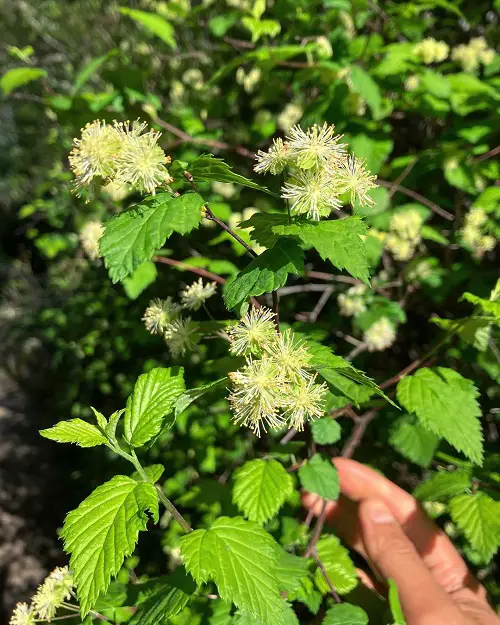
Scientific Name: Neviusia cliftonii
Status: Rare and Endangered
Discovered only in 1992, this ancient shrub lives in Shasta County in northern California. Floods from Shasta Lake eradicated a bunch during World War 2, leaving less than 20 occurrences of these plants today.
In addition to habitat loss, it faces threats from mining and logging, which could destroy the small area where it naturally exists.
22. Haha 
Scientific Name: Cyanea superba
Status: Extinct in the wild
The Haha plant sports large, lobed leaves and yellow, orange, or creamy tubular flowers. It used to be everywhere in Oahu but is now extinct in the wild and is one of the most endangered flowers in Hawaii.
Threats include invasive species, habitat loss, and low reproduction. Luckily, scientists are growing them back safely and restoring them.


